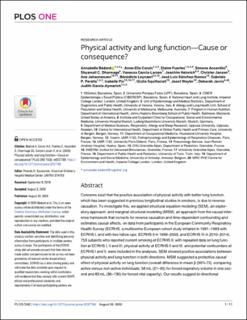Physical activity and lung function—Cause or consequence?
Bédard, Annabelle; Carsin, Anne-Elie; Fuertes, Elaine; Accordini, Simone; Dharmage, Shyamali C.; Garcia-Larsen, Vanessa; Heinrich, Joachim; Janson, Christer; Johannessen, Ane; Leynaert, Bénédicte; Sánchez-Ramos, José Luis; Peralta, Gabriela P.; Pin, Isabelle; Squillacioti, Giulia; Weyler, Joost; Jarvis, Deborah; Garcia-Aymerich, Judith
Journal article, Peer reviewed
Published version

Åpne
Permanent lenke
https://hdl.handle.net/11250/2759987Utgivelsesdato
2020Metadata
Vis full innførselSamlinger
Sammendrag
Concerns exist that the positive association of physical activity with better lung function, which has been suggested in previous longitudinal studies in smokers, is due to reverse causation. To investigate this, we applied structural equation modeling (SEM), an exploratory approach, and marginal structural modeling (MSM), an approach from the causal inference framework that corrects for reverse causation and time-dependent confounding and estimates causal effects, on data from participants in the European Community Respiratory Health Survey (ECRHS, a multicentre European cohort study initiated in 1991–1993 with ECRHS I, and with two follow-ups: ECRHS II in 1999–2003, and ECRHS III in 2010–2014). 753 subjects who reported current smoking at ECRHS II, with repeated data on lung function at ECRHS I, II and III, physical activity at ECRHS II and III, and potential confounders at ECRHS I and II, were included in the analyses. SEM showed positive associations between physical activity and lung function in both directions. MSM suggested a protective causal effect of physical activity on lung function (overall difference in mean β (95% CI), comparing active versus non-active individuals: 58 mL (21–95) for forced expiratory volume in one second and 83 mL (36–130) for forced vital capacity). Our results suggest bi-directional causation and support a true protective effect of physical activity on lung function in smokers, after accounting for reverse causation and time-dependent confounding.
